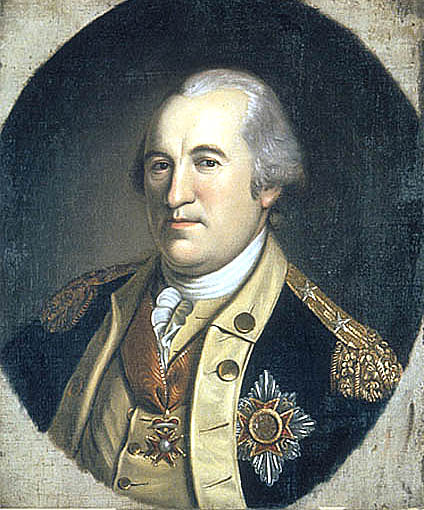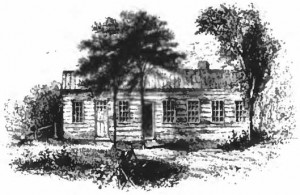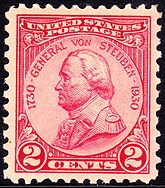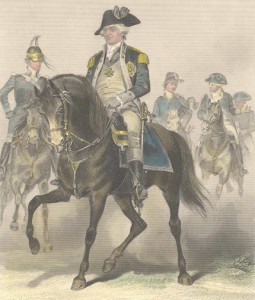Frederick Von Steuben

In Brief:
Born – September 17, 1730
Died – November 28 1794
Friedrich Wilhelm Augustin Ludolf Gerhard (Frederick William Augustus Henry Ferdinand) von Steuben also referred to as the Baron von Steuben was born September 17, 1730 and died November 28, 1794.He was a Prussian (region of Germany) aristocrat and military officer who served as inspector general and Major general of the Continental Army during the American War of Independence. He is credited with teaching the Continental Army the essentials of military drill and discipline, helping to guide it to victory after the difficulties during the winter at Valley Forge. He wrote the Revolutionary War Drill Manual, the book that became the standard United States drill manual until the War of 1812, and served as General George Washington’s chief of staff in the final years of the war.
Main Points
- He was born on September 17 1730 in Magdeburg, duchy of Magdeburg, in Germany.
- Steuben was schooled in Breslau by Jesuits and by the age of 16 he was an officer in the Prussian military.
- He travelled to Paris in the summer of 1777 and was introduced to Claude Louis who further introduced him to Benjamin Franklin.
- He was introduced to George Washington by means of a letter from Franklin saying Von Steuben was a ‘Lieutenant General in the King of Prussia’s service.
- He reached Boston on September 26thof 1777. By February 5th, 1778 he had offered to volunteer without pay but by the 23rd Steuben reported for duty to George Washington at Valley Forge.
- His training technique was the model company which meant he trained 120 soldiers who then trained other soldiers.
- He developed camp sanitation.
- One of his biggest contributions to the American Revolution was training in the use of the Bayonet which was a cooking skewer used as a weapon.
- They won the battle of Barron Hill on 20th of May 1778 and again at the Battle of Monmouth in June 1778.
- Washington recommended appointment of Von Steuben as Inspector General on April 30th and Congress approved it on May 5th.
- After they won the war Steuben resigned from service.
- He died on November 28th 1794.
- He is buried at what is now the Steuben memorial state historic site.
……………………………………………………………………………………………………………………………………………………………………………………………….
Early Life
Friedrich von Steuben was born in Magdeburg, Duchy of Magdeburg, in Germany.His father Wilhelm Augustin von Steuben (1699-1783),was a lieutenant of engineers. His mother was Elizabeth von Jagvodin. Steuben accompanied his father to the Russian Empire when Friedrich Wilhelm I, King of Prussia and Elector of Brandenburg, ordered Wilhelm into the service of Czarina Anna. The family returned to Prussia after the accession of Frederick the Great to the throne in 1740.
Steuben was schooled in Breslau by Jesuits and, by the age of 16, was an officer in the Prussian military. During the Seven Years’ War he was a member of an infantry unit but served primarily as a staff officer. By 1761 he had risen to the rank of captain and was serving in the Prussian general headquarters as aid-de-camp of the king. In 1762 he was selected as one of thirteen members of the “special class for the art of war” (Spezialklasse der Kriegskunst). Headmaster of this class was the king himself. The army was greatly reduced in size at the end of the war, and Steuben was one of many Prussian officers suddenly without work. His Prussian military career would later be exaggerated—he was not one of Frederick the Great’s generals—but his experience on a professional general staff, an agency then practically unknown outside of Prussia, would prove to be valuable in his American career.
Steuben traveled to Paris in the summer of 1777. As luck would have it, he had formerly been introduced to the French Minister of War, Claude Louis, Comte de Saint-Germain. The Count, fully realizing the potential of an officer with Prussian general staff training, further introduced him to Benjamin Franklin. Upon the Count’s recommendation, Steuben was introduced to George Washington by means of a letter from Franklin as a “Lieutenant General in the King of Prussia’s service,” an exaggeration of his actual credentials that appears to be based on a mistranslation of his service record. He was advanced travel funds and left Europe from Marseilles.[3]
In America
On September 26, 1777,Von Steuben his Italian greyhound, Azor (which he took with him everywhere), his young aide de camp Louis de Pontiere, his military secretary Pierre Etienne Duponceau, and two other companions, reached Portsmouth, New Hampshire and by December 1, was extravagantly entertained in Boston. Congress was in York, Pennsylvania, after being ousted from Philadelphia by the British advance. By February 5, 1778, Steuben had offered to volunteer without pay (for the time), and by the 23rd, Steuben reported for duty to Washington at Valley Forge. Steuben spoke little English and he often yelled to his translator, “Here! Come swear for me!” Colonel Alexander Hamilton and General Nathanael Greene were of great help in assisting Steuben in drafting a training program for the Army, which found approval with Washington.

Painting of Von Steuben at Valley Forge
Training the Continental Army
Steuben’s training technique was to create a “model company”, a group of 120 chosen men who in turn successively trained other personnel at Regimental and Brigade levels. Steuben’s eclectic personality greatly enhanced his mystique. He trained the soldiers, who at this point were greatly lacking in proper clothing themselves, in full military dress uniform, swearing and yelling at them up and down in German and French. When that was no longer successful, he recruited Captain Benjamin Walker, his French-speaking aide, to curse at them for him in English. Steuben introduced a system of progressive training, beginning with the school of the soldier, with and without arms, and going through the school of the regiment. This corrected the previous policy of simply assigning personnel to regiments. Each company commander was made responsible for the training of new men, but actual instruction was done by selected sergeants, the best obtainable. Another program developed by Steuben was camp sanitation. He established standards of sanitation and camp layouts that would still be standard a century and a half later. There had previously been no set arrangement of tents and huts. Men relieved themselves where they wished and when an animal died, it was stripped of its meat and the rest was left to rot where it lay. Steuben laid out a plan to have rows for command, officers and enlisted men. Kitchens and latrines were on opposite sides of the camp, with latrines on the downhill side. There was the familiar arrangement of company and regimental streets.
One of Steuben’s biggest contribution to the American Revolution was training in the use of the bayonet. Since the Battle of Bunker Hill, Americans had been mainly dependent upon using their ammunition to win battles. Throughout the early course of the war, Americans used the bayonet mostly as a cooking skewer or tool rather than as a fighting instrument. Steuben’s introduction of effective bayonet charges became crucial. In the Battle of Stony Point, American soldiers attacked with unloaded rifles and won the battle solely on Steuben’s bayonet training.

Winter at Valley Forge
The first results of Steuben’s training were in evidence at the Battle of Barren Hill, 20 May 1778 and then again at the Battle of Monmouth in June 1778. Steuben, by then serving in Washington’s Headquarters, was the first to determine the enemy was heading for Monmouth. Washington recommended appointment of Steuben as Inspector General on April 30; Congress approved it on May 5. During the winter of 1778-1779, Steuben prepared Regulations for the Order and Discipline of the Troops of the United States, commonly known as the “Blue Book.”[2][3] Its basis was the training plan he had devised at Valley Forge[4].
The Southern Campaign
In 1780 Steuben sat on the court-martial of the British Army officer Major John André, captured and charged with espionage in conjunction with the defection of General Benedict Arnold. He later traveled with Nathanael Greene, the new commander of the Southern campaign. He quartered in Virginia since the American supplies and soldiers would be provided to the army from there. During the spring of 1781, he aided Greene in the campaign in the south, culminating in the delivery of 450 Virginia Continentals to Lafayette in June.
He was forced to take sick leave, rejoining the army for the final campaign at Yorktown, where his role was as commander of one of the three divisions of Washington’s troops. Steuben gave assistance to Washington in demobilizing the army in 1783 as well as aiding in the defense plan of the new nation. He was discharged from the military with honor on March 24, 1783.
Later Years
With the war over, Steuben resigned from service and first settled on Manhattan Island, where he became a prominent figure and elder in the German Reformed Church. However, even with Congress giving him large sums of money, he still managed to become largely indebted. Thus, Congress gave him a pension of $2,500 a year which he had to keep until his death. Steuben eventually settled on a small estate in the vicinity of Utica, New York, on land granted to him for his military service

Steuben’s log cabin residence at Utica[6] He later assisted in the founding of the Society of the Cincinnati and was appointed a Regent for what evolved into the State University of New York. He never married and had no children. He left his estate to General Benjamin Walker and Captain William North, who had served as his aides-de-camp during the war, and with whom he had had an “extraordinarily intense emotional relationship … treating them as surrogate sons. He died on 28th of November 1794. He is buried at what is now the Steuben Memorial State Historic Site.
 …………………………………………………………………………………………………………………………………………………………………………………………………….
…………………………………………………………………………………………………………………………………………………………………………………………………….
What Von Steuben brought to the Continental Army
[youtube]http://www.youtube.com/watch?v=oGfVEqCEHVo[/youtube]
……………………………………………………………………………………………………………………………………………………………………………………………………
History@Banagher College, Coláiste na Sionna, Co. Offaly
The URI to TrackBack this entry is: http://teachnet.eu/tobrien/about/revolutions/the-american-revolution/frederick-von-steuben/trackback/
3 Comments Leave a comment.
Leave a Comment
You must be logged in to post a comment.

i didnt know that von steuben got them to start using thebayonet as a weapon its weird dat dey used it 4 cooking
I did’nt know that von steuben lived in a log cabin in utica in his last years
Great blog.. Very well layed out. I didn’t know they had his face on a stamp back then.. or that stamps were only 2 cent each! 🙂